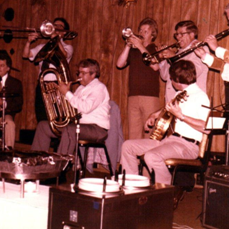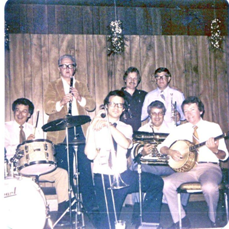A number of small CD companies make available “historic” recordings of hot jazz — often with fabled players no longer with us. One of the best of these companies is Dick Karner’s TradJazz Productions, and a particularly endearing CD issue (TJP 2145) is
THE CHARLESTON CHASERS
(IN MEMORY OF RUTH AND MARSHALL LORD)
Son Jack Lord — banjo player and nominal leader of the ensemble captured here) tells the story:
“My mom was a real flapper. She and my dad met in high school, class of 1926. They loved jazz and were quite the dancers. They used to tell how everyone at a dance would stand in a circle around them and watch them do the Charleston (they especially liked to dance to Sweet Georgia Brown). Fast forward to 1953, and son Jack goes to Purdue and is introduced to a band called THE SALTY DOGS. After following them around for several years, I finally got the banjo chair. My folks were huge fans, never missing a Chicago job. So for their 50th anniversary in 1977, it seemed like a great idea to get as many of the old Dogs together and have a party at the Sabre Room where the band played many times in earlier days. Dick Karner drove up from Lafayette, and as luck would have it, Bob Rann and Leon Oakley were in Chicago from California for the Electronics Convention. The players from Chicago from the old days were Tom Bartlett, Frank Chace, and Jack Carrell. Much forgiveness is necessary for the quality of the recording as it was done on a little voice recorder. Intros are missed, tags are cut off, and to say the fidelity is poor is an understatement. However, I think it conveys the spirit of the evening with a very hot pick-up band.”
Jack was fortunate in his choice of parents, and having this band play for their party is a true expression of gratitude — not only for them, but for the generations in this century who can now hear the music. The personnel is Jack, banjo; Leon Oakley, cornet; Jack Carrell, trumpet; Tom Bartlett, trombone; Frank Chace, clarinet; Bob Rann, tuba; Dick Karner, drums. The songs (some misidentified on the cover) are TISHOMINGO BLUES / SHAKE THAT THING / TROUBLE IN MIND / MY HONEY’S LOVIN’ ARMS / I WOULD DO ANYTHING FOR YOU / BLACK AND BLUE / DOCTOR JAZZ / FRIENDLESS BLUES / SWEET GEORGIA BROWN / PENNIES FROM HEAVEN / CANAL STREET BLUES / SEE SEE RIDER / AFTER YOU’VE GONE / JELLY ROLL / BIG BUTTER AND EGG MAN.
Dick Karner adds a little bit to the story (as do the photographs by Reta Karner):
“Through the ‘50’s while we (Dogs) were in college, Mr. and Mrs. Lord were our hosts on all our weekend gigs in Chicago. Jack wanted to do something special for their 50th wedding anniv. They really loved the band, so Jack tried to round up as many of the ‘55 members (Dogs) as he could for a surprise party at the Sabre Room where we had played a lot. He partially succeeded with the exception of Jim Snyder, John Cooper, Bill Price, who were on other gigs the night in question. None of us had played together for years. Jack had a small portable cassette player he left on all evening. This was a fun time. We had a ball playing. A few months later Jack sent me a copy of the cassette tape. Sound was not very good, but I worked on it for a long time—used what was marginal at best, and we decided to go ahead and release the CD. Frank was outstanding and very relaxed in his solos as was Leon, Tom and the rest of us…even without a piano player. A true impromptu session of some great music and one hell-of-an-anniversary gift for Mr. and Mrs. Lord who loved it!”
Jack and Dick are correct but perhaps too severe in their assessment of the fidelity. It’s far below official studio standards. What one hears in this slice of history is the party — from within the band.
And with no slight meant to the living members of this ad hoc gathering, any evidence of clarinetist Frank Chace in action is precious. I think none of the members of the band were (excepting Jack) particularly aware that a recorder was running, and certainly the partygoers do not sit in hushed silence, which leads to a particular kind of musical abandon. On a few occasions, a guest’s speech breaks in to the music (as happens in many live settings) — but in general, the recording is clear, the microphone placement effective.
I recommend it highly. The level of inspiration is very high, and it is a true glimpse behind the scenes of hot jazz in action. I wrote — during Frank’s lifetime, much to his pleasure, that one could learn so much about taking risks in solo playing and in ensemble work from any recording or performance of his, and THE CHARLESTON CHASERS is, in its own way, another graduate seminar in Chace — with thanks to Lord, Oakley, Bartlett, Rann, Carrell, and Karner, professors of Hot.
I miss Frank Chace, and this CD is both exciting evidence of what he did so often during his playing years and reason to feel that we lost someone rare.
The TradJazz Productions site is here — full of other clandestine and official marvels, featuring Kim Cusack, Bud Freeman, Hal Smith, the Salty Dogs, Bob Helm, Burt Bales, Birch Smith, Jim Snyder, Ben Cohen, Turk Murphy, Lu Watters, the South Frisco Jazz Band, Gremoli, Ev Farey — and three dozen other luminaries — music you don’t see at your local record store these days.
May your happiness increase!






